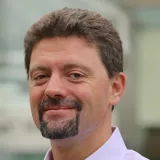A new Magnetic Resonance Elastography (MRE) technique allows for unparalleled penetration of mechanical waves in the body.

Professor Ralph Sinkus and his team have developed a new Magnetic Resonance Elastography (MRE) technique based on Magnetic Resonance Imaging (MRI) that uses low-frequency mechanical waves to generate quantitative maps of stiffness in body tissue.
The new technique holds the potential to significantly and positively impact patient pathway and prognosis by detecting abnormalities in liver stiffness non-invasively and at an early stage.
Metabolic dysfunction-associated steatotic liver disease (MASLD) is the most common liver disease in Western countries, with an estimated prevalence of 20-30%. Such disease may progress to cirrhosis, liver failure, and hepatocellular carcinoma if not detected on time.
Our team came up with a very innovative solution using the forces generated by a fast-spinning eccentric mass as source. We coined the approach "gravitational transducer" as it uses the equivalence of acceleration to force. The concept is like the technology that makes one's cell phone vibrate.
Professor Ralph Sinkus, Professor of Biomedical Engineering, School of Biomedical Engineering & Imaging Sciences, King's College London
Professor Ralph Sinkus and his team worked during five years on the EU-funded Horizon 2020 project entitled "Imaging the Force of Cancer" to address the fundamental need in the planning and monitoring of cancer treatment by measuring the mechanical forces active in cancer.
This innovation is in the process of being commercially translated to the clinic thanks to the support and guidance provided by the European research and development ecosystem. The project was supported by the European Commission in 2016 as part of the Horizon 2020 program.
As part of this project, Professor Sinkus and his team designed and engineered a new MRE solution based on a gravitational transducer system that allows for unparalleled penetration of mechanical waves in the body, and relies on a software implementation designed to process 3D wave data, whereby more pertinent biomechanical information can be probed.
The solution has been tested at several institutions, including the Guy's and St Thomas Hospital, the Beaujon Hospital in Paris, the Universities of Frankfurt and Heidelberg in Germany, the NIH and Harvard (Martinos Center for Biomedical Imaging) in the USA, and others.
Professor Sinkus's team includes Omar Darwish (King's College London, now Siemens Healthineers), Dr. Radhouene Neji (King's College London, formerly Siemens Healthineers), and Dr. Giacomo Annio (LVTS INSERM, Paris).
This is a prime exemplar of the model of co-creation between the academic sector and industry. I am very proud we are working with industry partners to deliver benefits to patients at scale. This project demonstrates the uniqueness of these special partnerships.
Professor Sebastien Ourselin FReng FMedSci, Head of the School of Biomedical Engineering & Imaging Sciences, King's College London
The work is now being used as the basis for the development of a product solution by the company Quality Electrodynamics, LLC (QED), a leading supplier of advanced technologies for MRI systems, with Siemens Healthineers, a global leader in Magnetic Resonance, being the first vendor planning to offer this new solution for its 1.5T and 3T MRI scanners.
Early detection of liver disease is vital for effective treatment and survivorship. In this context, we are proud to be the first to offer a new Magnetic Resonance Elastography device. We collaborate with both renowned research partners and 3rd party companies to translate innovative methods into new solutions. These partnerships are key to bringing new methods into the clinic faster - for the benefit of patients.
Rebecca Ramb, Vice President Magnetic Resonance, Research & Clinical Translation, Siemens Healthineers.










